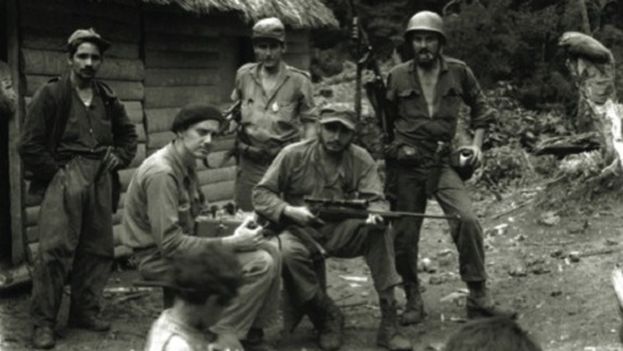
![]() 14ymedio, Regina Coyula, Havana, 8 March 2016 — “It was the Revolutionary government in Cuba that pushed the situation to the rupture of diplomatic relations in January 1961.”
14ymedio, Regina Coyula, Havana, 8 March 2016 — “It was the Revolutionary government in Cuba that pushed the situation to the rupture of diplomatic relations in January 1961.”
It is well known that Herbert Matthews’ interview of Fidel Castro in the Sierra Maestra, shortly after the landing of the yacht Granma, favorably predisposed American public opinion towards the personality of the guerrilla leader and the objectives of his struggle, which had been detailed in the document “History Will Absolve Me.”
However, in the months following the triumph of the Revolution, the summary trials and executions of numerous collaborators of the overthrown Batista regime served to tarnish in this good impression. It was not possible to overlook the judgment annulled in a public speech by Fidel Castro – an attorney well acquainted the procedures – of the aviators in Santiago de Cuba in February, which ended with the suicide of Felix Pena, commander of the Rebel Army and president of the court that absolved them.
A revolutionary movement recently installed in power, in a small and underdeveloped country, needed international sympathy to pave the diplomatic path. Matthews created the conditions to organize a trip for Fidel Castro to the United States. The Cuban leader visited the country in April 1959, at the invitation of the American Society of Newspaper Editors, thanks also to the mediation of the journalist Jules Dubois.
The revolutionary government had been recognized by the United States, but by the date of the trip the executions were figuring prominently; in fact, a reading of Fidel Castro’s speeches at Princeton, Central Park in New York, and the Hilton Hotel in Washington, suggest the effort to leave the hearer (and public opinion) the impression of a humanist, familiar with bourgeois values, and one who would accommodate a political correction acceptable to American citizens.
Eisenhower rejected a personal meeting with Castro, to establish distance and because Fidel Castro was a political conundrum. Allen Dulles’s intelligence agencies could not help but observe that in the security bodies recently created by the rebels, members of the Communist Party were invited to participate; the same Party that followed directions from Moscow not to join the anti-Batista guerrillas.
But as historian Ramirez Cañedo has confirmed, what was happening in Cuba was calculated, and affinities increasingly outlined with the Soviet Union did not arouse optimism in Washington. In terms of bipolarity and the Cold War, of course, the turn of events in Cuba must have been of great concern to the anti-communist Eisenhower and his government. Anti-communism was the natural state of the immense majority of the politicians on Capitol Hill, who had accepted with relief a nationalist government in Cuba, but one as far from Moscow as they themselves were.
“…the nationalization of U.S. properties in 1959 and 1960 was not a deliberate provocation by Cuba to seek a break in relations with the United States, but a necessity of the Revolution, planned by Fidel since 1953, in his famous plea of self-defense before the courts of the Batista tyranny, “History Will Absolve Me,” and foreseen in the 1940 Constitution.” [Source]
This is an interpretation. While giving land to the peasants was an aspiration of the 1940 Constitution and was contained in the well-known plea “History Will Absolve Me,” the measure had a scope much greater than an act of justice for tenants and sharecroppers. The lands given to individual farmers and to the cooperatives created by the National Institute of Agrarian Reform (INRA) were expropriated; but on expropriating every extension exceeding 400 hectares, most of the land remained in the hands of the state through INRA.
A considerable number of farmers benefited, receiving land that was of good quality and, in many cases, idle. The large landholdings that were productive remained in state hands under the name of People ‘s Farms, a name, by the way, that disappeared from the official vocabulary many years ago.
With respect to compensation, the environment did not favor a difficult collaboration with those affected, who could not understand how the leader of the Revolution spoke of slander when he was accused of being a communist, while meanwhile he was dynamiting the pillar of private property and enjoying vodka and caviar, according to the correspondent from the Soviet news agency Tass, the future ambassador of the USSR in Cuba.
Investments of the other countries affected by nationalizations did not reach a third of that of the United States, so it was relatively easy to reach agreements on compensation. The Revolutionary government offered to pay with 20-year bonds with 4.5% annual interest. However, the U.S. companies were demanding cash, which the Cuban government didn’t have, and as their bank reserve was depleted and they were not willing to divert money “to pay the landowners.”
The popular phrase “everything is in the eye of the beholder” serves well with regards to this long dispute. Combing through this skein of secrets, tangles, polarized testimonies and all the elements needed to approach the truth seems a task more suited to the historians of the future, although approximations are always welcome.
